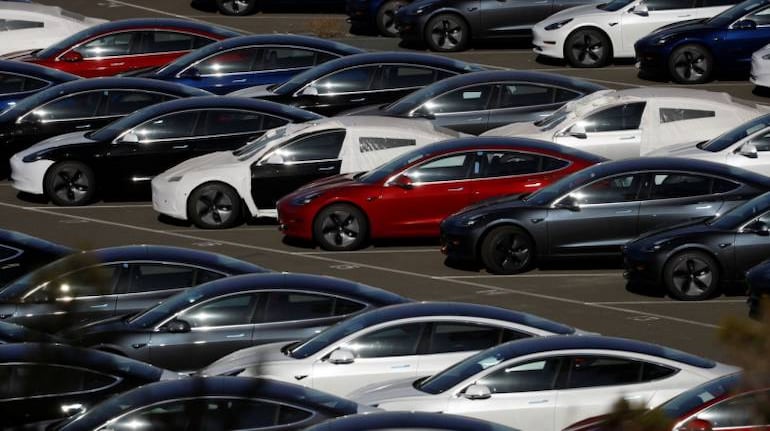



After browsing the vehicle lot for at least a year, President Joe Biden has plumped for the hybrid. New tailpipe emissions standards announced Wednesday by the Environmental Protection Agency represent an attempt to balance climate imperatives with consumer preferences, technological stretch goals with industrial capabilities, and, perhaps most acutely, the environmental and labour wings of Democrats.
When the EPA issued the proposed standards almost a year ago in April in a push toward a rapid electrification of passenger vehicles, they drew the expected criticism from Republicans and oil industry-linked interests. But they also received a cautious response from legacy automobile manufacturers and the United Auto Workers union, which feared a dash for electric vehicles was beyond Detroit’s current capabilities and would result in factories being shuttered.
Time has only lent weight to the arguments made by the critics in Detroit and at the UAW. Both General Motors Co and Ford Motor Co have stumbled in their EV efforts, with Ford’s newly segmented financial results showing it lost an average of more than $40,000 on each EV sold in 2023. Both have reset growth targets for battery-based vehicles and talked-up prospects for plug-in hybrids as an alternative. Growth in EV sales overall has slowed, prompting price cuts that have hit even industry leader Tesla Inc. In the fall, when the UAW staged a successful strike, its pugnacious leader Shawn Fain made no secret of his unease about what electrification might mean for the union, and notably withheld public support for Biden’s re-election efforts for months.
The EPA’s final rule now hews toward the less strict alternatives outlined in April’s proposal, resulting in emissions-per-mile targets falling 49 percent by 2032 rather than 56 percent. More importantly, the trajectory for tightening is flatter, requiring cuts later rather than sooner, therefore giving auto manufacturers more breathing room through the late 2020s.
Whereas the headline for April’s proposal, embraced by the EPA in its own announcement, was that battery vehicles’ share of sales could rise to 67 percent in 2032 under the new standards, the final rule points to a range of potential, and less ambitious, scenarios to meet the new goals. Most notably, while the central case sees battery EVs taking 56 percent of the market in 2032, the EPA also lays out an alternative pathway where they take only 35 percent, with plug-in hybrids rising to 36 percent.
Suggesting a viable, and potentially thriving, future for hybrids isn’t just designed to ease Detroit’s fears (Tesla won’t necessarily like it but maybe Biden thinks the company’s leader is a lost cause for Democrats anyway). The White House likely has the Supreme Court in mind, too. As the 2022 ruling against the Clean Power Plan showed, the court’s right-wing majority is gunning against regulatory deference to agencies, especially on vaguely defined “major questions” of policy. Just as revised power-plant emissions rules announced last May eschewed prescriptions of how utilities met tighter standards, so the EPA is at pains to show it isn’t dictating how manufacturers meet these new tailpipe targets.
Those power-plant rules recognised that keeping the grid reliable as it greens meant giving ground to natural gas plants, which are the main sources of backup for wind and solar for the foreseeable future. Similarly, tailpipe standards that leave more room for hybrids allows the country to leverage existing technology — the humble gas station — while mitigating vehicle emissions until battery EVs are cheap and desirable enough to fully supplant the internal combustion engine.
Such practicalities, while unlikely to win Biden plaudits from either end of the political spectrum, are aimed at the potentially persuadable middle. Wednesday’s announcement highlighted backing from environmentalists, trade associations and the UAW. The project of energy transition in the US has always been less about specific targets for this or that year in the future and more about maintaining the momentum required to invest in cleaner technologies, especially the supply chain that builds them. A US vehicle market in which EVs are “only” a third or half of sales would still be a market transformed and ripe for further transformation.
That momentum faces its biggest potential crash barrier this coming November, with the road running straight through states like Michigan. Apart from anything else, this hybrid is designed to avoid any skidding.
Liam Denning is a Bloomberg Opinion columnist. Views do not represent the stand of this publication. Credit: BloombergDiscover the latest Business News, Sensex, and Nifty updates. Obtain Personal Finance insights, tax queries, and expert opinions on Moneycontrol or download the Moneycontrol App to stay updated!
Find the best of Al News in one place, specially curated for you every weekend.
Stay on top of the latest tech trends and biggest startup news.